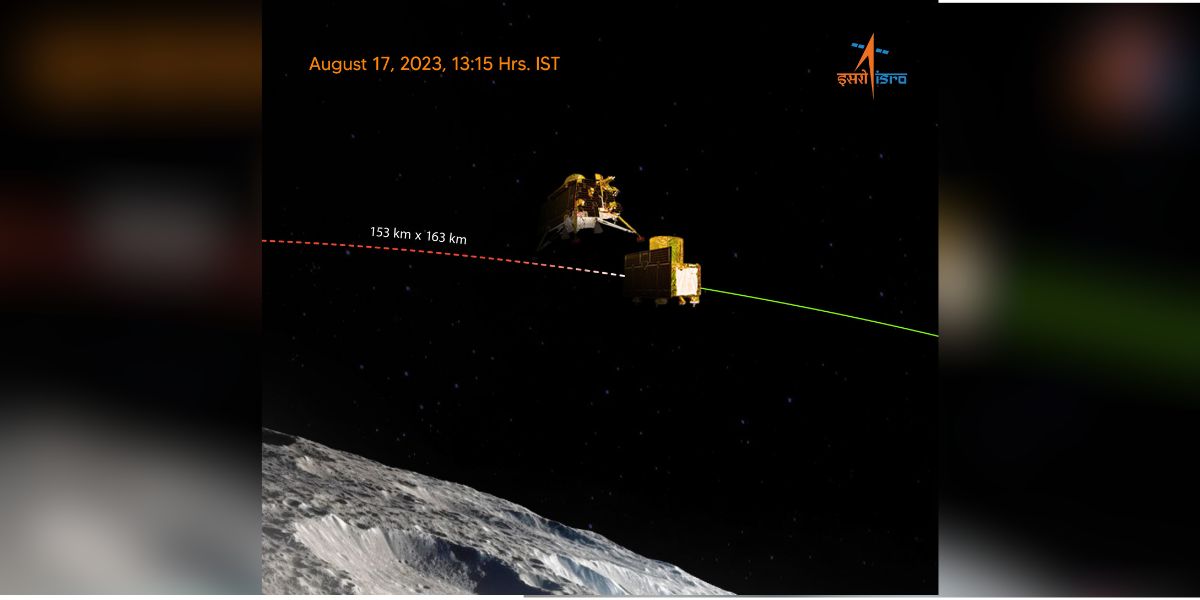The Lander Module comprising the lander and the rover is now ready to be lowered into an orbit that takes it closer to the Moon's surface.

The position of the Lander Module after the separation. (Twitter/isro)
Achieving a major milestone, ISRO on Thursday, 17 August, announced that the Chandrayaan-3 spacecraft’s Lander Module has successfully separated from the Propulsion Module that was propelling it all these days in space.
The Lander Module — comprising the lander (Vikram) and the rover (Pragyan) — is now ready to be lowered into an orbit that takes it closer to the Moon’s surface. The soft landing on the Lunar south pole is scheduled for 23 August.
“Thanks for the ride, mate! said the Lander Module (LM). LM is successfully separated from the Propulsion Module (PM). LM is set to descend to a slightly lower orbit upon a deboosting planned for tomorrow around 1600 Hrs., IST,” ISRO said in a post on X (formerly Twitter).
Chandrayaan-3 Mission:
‘Thanks for the ride, mate! 👋’
said the Lander Module (LM).LM is successfully separated from the Propulsion Module (PM)
LM is set to descend to a slightly lower orbit upon a deboosting planned for tomorrow around 1600 Hrs., IST.
Now, 🇮🇳 has3⃣ 🛰️🛰️🛰️… pic.twitter.com/rJKkPSr6Ct
— ISRO (@isro) August 17, 2023
After Thursday’s separation, the lander is expected to undergo a “deboost” (the process of slowing down) to place it in an orbit where the Perilune (the orbit’s closest point to the Moon) is 30 km and Apolune (farthest point from the Moon) is 100 km.
It is from there that the soft landing on the south polar region of the Moon will be attempted, ISRO sources said.
Meanwhile, the Propulsion Module will continue its journey in the current orbit for months/years, the country’s space agency said.
“The SHAPE (Spectro-polarimetry of Habitable Planet Earth) payload onboard it (Propulsion Module) would perform spectroscopic study of the Earth’s atmosphere and measure the variations in polarization from the clouds on Earth to accumulate signatures of Exoplanets that would qualify for our habitability!” ISRO said, adding that this payload is shaped by its UR Rao Satellite Centre in Bengaluru.
Chandrayaan-3 Mission:
Meanwhile, the Propulsion Module continues its journey in the current orbit for months/years.
The SHAPE payload onboard it would
☑️ perform spectroscopic study of the Earth’s atmosphere and
☑️ measure the variations in polarization from the clouds on…— ISRO (@isro) August 17, 2023
ISRO Chairman S Somanath had recently said the most critical part of the landing is the process of bringing the velocity of the lander from 30 km height to the final landing, and that the ability to transfer the spacecraft from horizontal to vertical direction is the “trick we have to play” here.
“The velocity at the starting of the landing process is almost 1.68 km per second, but this speed is horizontal to the surface of the moon. The Chandrayaan-3 here is tilted almost 90 degrees, it has to become vertical. So, this whole process of turning from horizontal to vertical is a very interesting calculation mathematically. We have done a lot of simulations. It is here where we had the problem last time (Chandrayaan-2),” Somanath explained.
Chandrayaan-I Project Director M Annadurai said: “It is a great moment and this will imply how the lander is performing and the lander will be verified and tested and brought closer and closer to the moon… then it will be given the required commands such that it takes over on cue on 23 August to go all the way to the targeted place and have a safe and secure landing.”
“This is the beginning and all further milestones have to be seen very carefully. We have crossed major milestones from the launch vehicle and after that the propulsion system (separation)… now really the match starts. These are the final overs we are talking about. I think it is a great moment. The whole world is waiting to see what Vikram will do and what Pragyan will come out and do… I am also enthusiastically waiting,” Annadurai told PTI.
Post its launch on 14 July, India’s third Moon mission Chandrayaan-3 entered into the lunar orbit on 5 August, following which orbit reduction manoeuvres were carried out on 6, 9 and 14 August.
As the mission progressed, a series of manoeuvres were conducted by ISRO to gradually reduce Chandrayaan-3’s orbit and position it over the lunar poles.
Over five moves in the three weeks since the 14 July launch, ISRO had lifted the Chandrayaan-3 spacecraft into orbits farther and farther away from the Earth.
Then, on 1 August in a key manoeuvre— the slingshot — the spacecraft was sent successfully towards the Moon from Earth’s orbit. Following this trans-lunar injection, Chandrayaan-3 escaped from orbiting the Earth and began following a path that would take it to the vicinity of the Moon.
Chandrayaan-3 is a follow-on mission to Chandrayaan-2 (2019) to demonstrate end-to-end capability in safe landing and roving on the Moon’s surface.
It comprises the indigenously developed Propulsion Module, the Lander Module, and the rover with the objective of demonstrating the technologies required for inter-planetary missions.
The mission objectives of Chandrayaan-3 are to demonstrate a safe and soft landing on the lunar surface, to demonstrate rover capabilities on the Moon, and to conduct in-situ scientific experiments.
A successful mission would mean India becomes only the fourth country to accomplish the challenge, after the US, the former Soviet Union, and China.
(With PTI inputs)

Aug 28, 2023

Aug 24, 2023

Aug 24, 2023

Aug 23, 2023

Aug 23, 2023

Aug 23, 2023